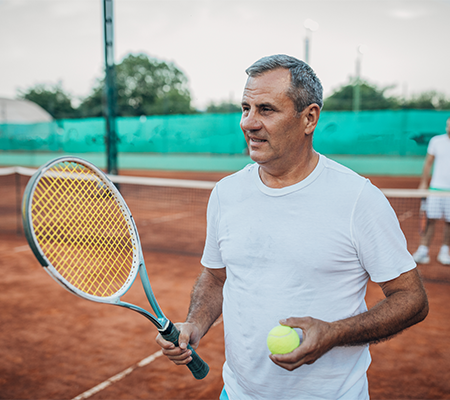
Lateral epicondylitis is a common orthopedic condition that impacts over 200,000 people every year in the U.S. Here are five things to know.
Lateral epicondylitis – sound familiar? Well, maybe not – but you may have heard it by the name: tennis elbow. This very common orthopedic condition impacts over 200,000 people every year in the U.S. and can get worse over time if left untreated.
Cynthia Koehler, P.T., Marshfield Clinic Health System physical therapist explains tennis elbow and how it’s treated.
What is tennis elbow?
Tennis elbow is inflammation or tearing of the tendons that connect the muscles of your lower arm to the bone, said Koehler.
The pain may start mildly, but can get worse when doing actions such as lifting or gripping an object and moving your arm in a repetitive motion.
“The location of tennis elbow is on the outside of your elbow as your palm is facing forward, standing with your arm at your side,” she said. “The outside of the elbow is where the muscles you use for extending or bending your wrist back are located.”
Koehler noted that a similar condition – golfer’s elbow – is located on the inside.
How common is it?
The condition is the most common reason why people visit their doctors with elbow pain. While people of all ages may get tennis elbow, it is seen most often with individuals between the ages of 30 and 50.
What causes tennis elbow?
Tennis elbow can come from playing a sport like tennis or racquetball, but it also can happen in people who use recurring arm movements in their everyday lives. This includes professionals, such as plumbers, carpenters, factory workers or others doing repetitive motions during their jobs and hobbyists who enjoy painting or knitting.
How is it treated?
The vast majority of patients with the condition are able to recover without surgery. Your doctor will recommend rest of the affected arm and may prescribe pain relievers like anti-inflammatory medication to help.
You may be referred to a physical therapist who will work on exercises that strengthen the impacted muscles and utilize techniques that improve healing.
Koehler said that the therapist also provides education and guidance regarding stretching, use of heat or ice, deep friction massage, and strengthening for home and other modalities that can be used in the clinic.
“Activity modification is the key to helping prevent recurrence,” she said. “Your physical therapist can help with that as well.”
Braces and cortisone injections also may play a role in recovery. If the symptoms do not get better over time, surgery may be advised.
Can you take steps to prevent tennis elbow?
It is important to avoid overuse of repetitive arm movements.
If you take part in activities that require these motions, stretching prior and proper technique can help with prevention.
Stopping when you are feeling elbow pain and icing the area if needed also are important considerations.
Learn more
If you are concerned you may have tennis elbow or are looking for additional information, a talk to your doctor or visit marshfieldclinic.org.
Related posts
Knee pain? Reasons to consider knee cartilage restoration
Hip impingement: 4 things to know

